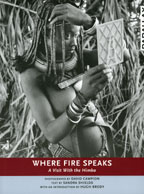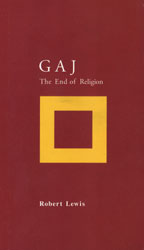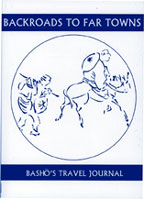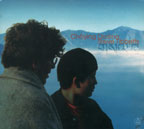Where Fire Speaks: A Visit with the Himba
by Sandra Shields
Arsenal Pulp Press 2003
 The labour of forging an identity is one we must all go through, both as individuals and as societies. Where Fire Speaks is the account of the Himba people’s struggle to preserve the identity they built over centuries of shared history, community lands, tribal customs, education, language and distinctive dress (or undress) as it comes in conflict with the pressures to go where the money is in northern Namibia.
The labour of forging an identity is one we must all go through, both as individuals and as societies. Where Fire Speaks is the account of the Himba people’s struggle to preserve the identity they built over centuries of shared history, community lands, tribal customs, education, language and distinctive dress (or undress) as it comes in conflict with the pressures to go where the money is in northern Namibia.
These pressures emerge internally from their desire to secure modern consumer goods and services, such as health care and education, and externally from the Namibian government’s insistence that they give up their old ways and accept development. This discord culminates in the high-scale government plan to build a dam on the river that has nourished and bathed the Himba and their cattle for hundreds of years.
The account is narrated by Canadian journalist Sandra Shields and photographer David Campion who, funded by the International Center for Human Rights and Democratic Development, spent two months with the Himba people living in their villages, and observing the minute details of their lives. To their credit, the authors are wise enough to offer only observations, not answers, and the tale is told in a self-effacing observational style that is very refreshing. Not once in the sixty black and white photos do we catch a glimpse of our would-be protagonists.
It is this retiring approach that allows us the furtive and intimate glimpses into the lives of the Himba as they attend evangelical church services, congregate around the liquor trader’s truck, journey to the big town to visit the hospital, and pose for tourists’ photographs. Activities that stand in stark contrast to their more traditional occupations of herding livestock and communing with holy fires, which are conduits of ancestral voices.
The act of taking photographs lies at the heart of Where Fire Speaks. The terrain being explored here is caught in the question that one Himba headman put to a film crew: “Why are you all so interested in us, anyway?” It is this very interest in the Himba tradition that set the wheels of assimilation in motion. Once they discovered that tourists would pay money to take their pictures, the act of posing for them in postcard-perfect formation became their chief industry. This tendency to become so self-aware at the first appearance of a camera was a great obstacle for Campion, who wanted to capture the Himba in their most candid moments.
This story caused me to reflect on the big question of why we go through such pains to create an identity at all. It brought to life the tenacious ways we cling to one in order to define who we are in relation to everything else, and how limiting a contrivance it really is.
I wondered: is it not possible to identify with the ALL, everything that IS, the entire world as it appears to us through every facet of our awareness? Perhaps this unbounded knowledge of self is the state called enlightenment, but until our awareness can reach the outer limits of no-end, we must deal with our painful sense of separation by forging an identity that unites us with all others who claim the same selfhood.
To the misfortune of the Himba people of northern Namibia and all other First Nations across the globe, the values that appeal to the world at large are changing and becoming more and more homogenized. – Izak Benrobi
back to top
Rumi’s Daughter
by Muriel Maufroy
Rider (Random House) 2004
 A story weaving together history, spirituality and simple truths, Rumi’s Daughter is one of those rare books that uplifts, inspires and causes long periods of reflection. I approached this book firstly due to the cover comment, “In the style of The Alchemist,” and my interest was piqued by my love of learning about foreign/ancient cultures in the context of a story. I was overjoyed to find much more.
A story weaving together history, spirituality and simple truths, Rumi’s Daughter is one of those rare books that uplifts, inspires and causes long periods of reflection. I approached this book firstly due to the cover comment, “In the style of The Alchemist,” and my interest was piqued by my love of learning about foreign/ancient cultures in the context of a story. I was overjoyed to find much more.
This is the tale of Kimya, a young girl in Anatolia who leaves her village to study in the city of Konya with the Sufi teacher Maulana, better known to us as Rumi. Words of profound wisdom are etched in the reflections of many of the characters, addressing issues such as love, death and separation in a deep and touching manner. Maufroy’s vivid writing has the knack of being able to provoke reflection in so many situations that I was forced every few pages to pause and contemplate how the truth I had just ingested related to my life. Seeing a different slant on spiritual awakening, I was inspired by the characters’ doubts and realizations along their journeys.
Culturally, the setting of Anatolia in the 1240s showed a slice of life where Muslims and Christians lived in an uneasy peace. History seeps through the story, a world so different to the one I have grown up with in the West. I read Rumi’s Daughter barely familiar with Rumi, but it didn’t matter. Sitting on a train through the English countryside, I was spellbound. The quiet certainty and grounded assurance of Kimya and her teachers overrides cultural and historic boundaries and spilled over into my own life.
A few months later as I intensify my own spiritual journey at an ashram in western Canada, I often think of Kimya and feel as if I am beginning to understand her story – the magical moments of blissful unity that are so precious and rare. – Sarah Spence
back to top
GAJ: The End of Religion
Robert Lewis
Hay River Books 2004
 Robert Lewis continues where Nietzsche left off in his exploration of The End of Religion. Not only is God dead, according to Lewis, religion as we know it has gone with it. Fortunately for everyone, there is something else, even if it’s not God or Allah or Jehovah. GAJ is an acronym for God Allah Jehovah, a term used by Lewis to unite the three monotheistic religions.
Robert Lewis continues where Nietzsche left off in his exploration of The End of Religion. Not only is God dead, according to Lewis, religion as we know it has gone with it. Fortunately for everyone, there is something else, even if it’s not God or Allah or Jehovah. GAJ is an acronym for God Allah Jehovah, a term used by Lewis to unite the three monotheistic religions.
Lewis begins his exploration with the following dedication: “To those who have been engaged by the dialogue and to those still to be so.” In so doing, Lewis invites anyone, from the most learned theologians to the casual observer of religion, to take part in his historical recapitulation of religion, as well as his theories on modern-day religious beliefs, in which New Physics plays a large part.
From Lao-Tzu to Buddha, Plato to Jesus, Mohammed, Descartes, Shakespeare and Einstein, Lewis provides a comprehensive guide to concepts of GAJ, starting from a religious perspective and then progressing onward in history to philosophies of GAJ and on to GAJ and New Physics.
When reading this book, I felt a profound sense of interconnectedness associated with all the examples touched upon by Lewis. Even though, as he states, the three great monotheistic religions of the West base their beliefs on a godhead who resides without, as opposed to the more pantheistic religions of the East, which base their beliefs on the spirit within, there is a strong balance between the two. "The problem with the Western religions," Jung insisted, "is their extroverted focus... As a result the Western mind represses what it fears in itself, seeks to destroy in others what it fears in itself."
To me, religious figures, philosophers, scientists and poets are all seeking out truth under whichever domain they seem to be most familiar with. The uniting factor in all of these is faith, and in Einstein’s words, “a rapturous amazement at the harmony of natural law.” To me, this is the essence of religiosity.
To Lewis, the New Physics has reached the same degree of influence as religion. He unites science with religion by probing the mysteries of quantum physics, where the observer cannot, at a certain point, be separated from the observed, right down to the smallest observable particle. The satisfaction of the mystery of the eternal, of the marvelous structure that is our universe, has always been present among us. It is in our attempt to define the mystery that we turn to religion, art, science and philosophy.
Lewis ends the book with an examination of Church and State and his criticism of how God is used to justify war. When both sides invoke God as their central battle cry, there is little chance for hope, seeing as both sides call upon the same God, thus creating a contradiction of God’s will. Perhaps a reconciliation of religious practice and Divine worship will bring about tolerance and respect in the world. The more people open their hearts and minds to other ways, the more people will realize that they're on the same side, and the greater chance we have for peace and prosperity as one nation under the sun. – Leslie Schachter
back to top
Chronicles I
by Bob Dylan
Simon & Schuster 2004
 Bob Dylan is known as a spiritual man, but also a loner, often offering opaque answers (or none at all) to direct questions. True to form, in Chronicles I there are many biographical omissions, and we are not given any real insights into his spiritual beliefs. However, what this autobiography does offer is a very engaging look at one man’s evolution with his own creative voice, both in light of, and in spite of, the public attention it has received. It is on this level that Chronicles I interested and challenged me.
Bob Dylan is known as a spiritual man, but also a loner, often offering opaque answers (or none at all) to direct questions. True to form, in Chronicles I there are many biographical omissions, and we are not given any real insights into his spiritual beliefs. However, what this autobiography does offer is a very engaging look at one man’s evolution with his own creative voice, both in light of, and in spite of, the public attention it has received. It is on this level that Chronicles I interested and challenged me.
Unlike Bob Dylan’s previous book, 1966’s Tarantula, which was a psychedelic roll through his subconscious, Chronicles I features an introspective Dylan writing plainly and openly about his creative process. For a famous recluse Dylan is remarkably exposed; however, many of the elements that defined Dylan’s musical path are dealt with only in passing—sometimes in a single sentence. In fact, in some cases the moments that made Bob Dylan into Bob Dylan are ignored completely. Counter to what many music critics and fans may have wanted or expected, we are not offered an autobiography that is a full, wide-screen disclosure. What we are given is an invitation into the creative process of one of popular music’s most significant icons.
We are given snapshots of the formation of the man at different stages of his career: the young man striving for success; the successful man striving for authenticity; the older man striving for inspiration. The book is an account of process, perseverance and passion, and we see Dylan struggling to form and understand the voice that he feels is uniquely his, recognized now as one of the most significant in pop culture in the last fifty-odd years.
To me, Chronicles I is at its best when it is showing the Dylan of the early 1960s, when he first arrived in New York City. Virtually alone in an unfamiliar city, Dylan began playing shows in folk clubs around Greenwich Village. We are told of how he forged his identity on hard-scrabble folk music and emulated the parts of other artists that he admired, in a slow opening of his creative scope and a honing of an authentic voice of his own. Collectors of rare folk albums provided source material that became Dylan’s foundation, and with a few specific musicians providing artistic epiphanies, Dylan’s unusual vision took over.
Dylan’s writing is a cadence of shortened sentences and clipped asides, and often reflects a wry humour that surprised me. But most impressive about Dylan’s prose style was how similar it is in tone to his music. Chonicles I displays the same combination of simple words and sentence structures, mixed with vivid and unusual metaphors that are characteristic of Dylan’s lyrics. Open the book to nearly any page and read for a paragraph or two and a voice you already know is reading to you. These lyrical skills have inspired a whole raft of pale imitators in a variety of genres, but are best used in the practised hands of an old pro.
I was also struck by Dylan’s admission that he notices details more than narrative, a trait that informs his music and his writing. When I think of any significant Dylan song, it is the frayed snippets of sepia-toned characters that emerge. There are vagabonds, dilettantes and debutantes in his songs, and so too, in his recounting of his life, where he tells stories about the people and the times that were forming around him. As one of the most heralded and most revered musicians in modern times, it is revealing to see the processes of the man behind the myth. – Scott W. Gray
back to top
Backroads to Far Towns: Basho’s Travel Journal
by Cid Corman and Kamaike Susumu
White Pine Press 2004
 A friend of mine recently completed a 350-kilometre walking pilgrimage in northern Manitoba. Her story chronicles the contrasts of stunning natural beauty and serenity with loneliness, danger and fatigue. Basho’s journal of his last pilgrimage in 1689, Backroads to Far Towns, expresses these same feelings and experiences through journal entries, haiku and Japanese ink drawings.
A friend of mine recently completed a 350-kilometre walking pilgrimage in northern Manitoba. Her story chronicles the contrasts of stunning natural beauty and serenity with loneliness, danger and fatigue. Basho’s journal of his last pilgrimage in 1689, Backroads to Far Towns, expresses these same feelings and experiences through journal entries, haiku and Japanese ink drawings.
To be part of this journey with the author and his companion, Soro, I read each page slowly and spent time with each image. Basho, Japan’s finest haiku writer, was skilled at infusing small details from everyday life with broad, universal meaning. He also communicates directly to the reader’s imagination and heart by using the simple moments of his life and a few carefully chosen words: “Sitting in temple hojo, rolling up blinds, eyes held the scene: to south Chokai supporting heaven, its image resting in water.”
Each entry of this short journal is multilayered. It records his actual journey and lodging from town to town, the friendship developed with his two walking companions, the author’s deep connection to the natural world and Zen, and his willingness to allow the reader to see and share in his humanness. Near the end of this trip, Soro became ill and had to return home. Basho wrote: “Pain of one who goes, emptiness of one left behind, like the parting of a pair of wild geese, lost in clouds.”
Much to my disappointment, the frequent reference to endnotes for the translation of numerous Japanese words and cultural inferences was at times distracting.
I would suggest entering into Backroads to Far Towns intuitively – that is, to allow Basho’s words and illustrations to open the door into the moments of his experience. While the journal entries and ink drawings carried me right into Basho’s heart and vision of the world, his ability to leave nothing between himself and the reader proves to be one of his great gifts. – Janet Gaston
back to top
Yoga Unveiled: The Evolution and Essence of a Spiritual Tradition (DVD)
produced by Gita and Mukesh Desai
written by Gita Desai
 According to yoga historian Dr. Georg Feuerstein, "While there has been a great interest in the discipline of yoga, we don’t yet have the proper context for an authentic engagement of yoga in the West. And that is why it’s not working."
According to yoga historian Dr. Georg Feuerstein, "While there has been a great interest in the discipline of yoga, we don’t yet have the proper context for an authentic engagement of yoga in the West. And that is why it’s not working."
Such insights, calls to action and an attempt to articulate the place of yoga in a Western culture context is the basis of the illuminating documentary Yoga Unveiled: The Evolution and Essence of a Spiritual Tradition. From the most basic first question, “What is yoga?” prominent Eastern and Western yoga scholars, teachers and medical experts are asked to comment on the theoretical, historical and philosophical elements of the oldest spiritual practice in the world. There is no lack of passion and reverence in their discourse. In fact, one gets the sense that many of them have been waiting a long time for a chance to speak about a tradition that has profoundly transformed many lives, is India’s gift to the world, and is frequently misunderstood.
At just over three hours, Yoga Unveiled interweaves five thousand years of yoga history and evolution with insightful and accessible contemporary analyses. A daunting task, no doubt, but under the direction of filmmakers Gita and Mukesh Desai, the story that unfolds is educational, entertaining, and at times humbling. From its roots in the ancient Harrapa civilization of the Indus Valley to the Indian yoga renaissance spearheaded by Sri T. Krishnamacharya, to the gradual rise of yoga in the West, the documentary shows a yoga that is never static, but rather an ever evolving product of its times, the pervading culture, and most profoundly and consistently, of our relationship with nature.
Early man’s dependence on nature caused its elements to become the first objects of worship, and asanas – literally translated from Sanskrit as “the seat upon which a yogi sits to meditate” – were postural representations of objects found in nature. Yoga practice was created as a way of preparing for meditation, because it was there where deep insights came. It was how the earliest yogis began exploring the self, which they discovered had the capacity to somehow understand the outer world. Adoption of the practice and rituals presented this mystery of change in a dramatic way, becoming a kind of sacred theatre through the connection of mind, body and spirit.
I especially enjoyed these stories of the “first yogis” whose practice started because they were simply fascinated by the world around them, wondering how was it possible that they saw what they saw and felt what they felt. Why did the seasons change? Why do we change? Who are we in relation to this vast natural world that feeds us, moves us and takes us closer to death? What is death? What is life? The ultimate beginner’s mind. The questions haven’t really changed, but our relationship to nature has. Fed by a reverence to and bewilderment by nature, yoga’s goal has always been the realization of the innermost self, but now in the West we seem to have divorced ourselves from this mystery for the comfort of intellectual, rational fact.
In Yoga Unveiled, there is hope that a new context, and interpretation of this union is possible. In India, the questions preceded the postures. In the West, however, the opposite seems to be the case. This does not mean we have it all wrong, but there seems to be a consensus that – through trial and error – more work and study are necessary if we are to offer anything to yoga’s dynamic heritage.
The filmmakers and panelists don’t offer any cut and dried answers, but one is left charged with questions and excitement for the possibilities. I was also reminded that, like its history, yoga is a long, transformative process, and only through a synthesis of practice, study, and most importantly, a sense of wonder can we hope to renew our relationship with nature, create a more authentic context for yoga in the West, and continually encounter our true selves. – Gunthar Ragnarsson
back to top
Selwa
Chöying Drölma and Steve Tibbetts
Six Degrees Records 2004
| click here to listen |  |
 As I try to place into words the resonance and impact of Chöying Drölma and Steve Tibbetts’ album Selwa, I recognize that these ancient mantras have acted as a refuge to my questing mind. Without understanding the Tibetan language, I am forced to concentrate on the tones rather than the meanings of words. Each syllable has its own definition: one means sorrow, another laughter, one means praise, another lamenting.
As I try to place into words the resonance and impact of Chöying Drölma and Steve Tibbetts’ album Selwa, I recognize that these ancient mantras have acted as a refuge to my questing mind. Without understanding the Tibetan language, I am forced to concentrate on the tones rather than the meanings of words. Each syllable has its own definition: one means sorrow, another laughter, one means praise, another lamenting.
Selwa–which means luminous clarity– is an East-West collaborative effort, by guitarist Steve Tibbetts and Buddhist nun Chöying Drölma, which bends the barriers of traditional chants by bringing in the elements of modern jazz and a percussive melody. The album was recorded in a remote monastery in northern Tibet. The reflection cultivated there is captured in the atmosphere of Selwa. Within the temple acoustics, stillness and sound meet to reflect each other, as simple percussion and echoing chants act as background to Chöying’s solitary voice.
Chöying sings hymns passed down through hundreds of years, while the strings of Tibbetts’ guitar resonate as water. From the thunderclaps of the shoreline, into inner caves and still wells, we follow tones and sounds that are both serene and stirring. I allow myself to drift through the landscape of her voice and am brought to the still quiet of the mountains and deep lakes of her home. I witness these songs of transformation, and am unable to remain a separate, critical listener.
Born in Nepal, Choying Drolma entered the Nagi Gonpa monastery at age twelve. Despite initial disregard from the monks, she was granted the vows of refuge and eventually became a chant master. Unable to see life outside the monastery as fulfilling, she found sanctuary in traditional hymns and mantras. Calling herself a child of the mountains, she chants:
I do not recognize me to be me
I am the supreme victor, the wish-fulfilling jewel.
I do not recognize this song to be a song
it is the laughter of the glorious heruka.
From the inner shrine room, these songs call me into contemplation, allowing the space for both silence and sound. Her words are as molasses to my ears, reminding us to cherish the practice itself, for the practice is the joy. –Anne Read
back to top